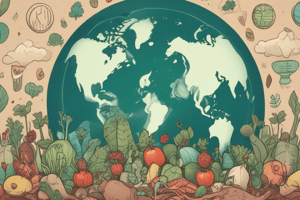Podcast
Questions and Answers
What was the initial plan for the waste produced by the cafeteria?
What was the initial plan for the waste produced by the cafeteria?
- To use it to grow vegetables on a vertical farm
- To use it as a source of energy
- To recycle it directly into fertilizers (correct)
- To dispose of it in a landfill
What was the main challenge faced by the team during the initial setup?
What was the main challenge faced by the team during the initial setup?
- Difficulty in finding a suitable location
- Lack of funding for equipment
- Risks and challenges involved in setting up each step (correct)
- Competition from existing vertical farms
Why did the team decide to pivot from food production?
Why did the team decide to pivot from food production?
- Due to lack of funding for equipment
- Because of competition from existing vertical farms
- To focus on solving one problem at a time (correct)
- Because of the risks involved in setting up a sales channel
What was the final plan for the fertilizer produced?
What was the final plan for the fertilizer produced?
What was the purpose of the worm farm in the initial design?
What was the purpose of the worm farm in the initial design?
Flashcards
Cafeteria Waste Plan
Cafeteria Waste Plan
The initial plan was to recycle cafeteria waste directly into fertilizers to create a closed-loop system.
Setup Challenge
Setup Challenge
The main challenge during the initial setup was managing the risks and complexities involved in setting up each step of the waste recycling process.
Pivot to Fertilizer
Pivot to Fertilizer
The team decided to pivot from food production to focus on solving the waste problem first.
Fertilizer Testing
Fertilizer Testing
Signup and view all the flashcards
Worm Farm Purpose
Worm Farm Purpose
Signup and view all the flashcards
Study Notes
Nutrinity Concept
- Concept built on reducing food waste from the environment
- Identifying opportunities in the entire supply chain of food waste to reduce it
- Focusing on areas of expertise to create solutions for each challenge
Closed-Loop System
- Designed self-sustainable, energy-efficient greenhouse farming units for upcycling food waste
- Implementing circular economy principles to reduce overall waste
- Created a closed-loop system with inputs and outputs at each step, considering partnerships and tools needed
Biogas Reactors
- Researched different biogas reactors suitable for food waste
- Partnered with delivery companies (Foodora/Wolt) for waste collection
Fertilizer Production
- Identified suppliers for reactors and fertilizers
- Determined type of fertilizer needed and optimization methods
- Collaborated with universities for space procurement and access to students for practical experience and research
University Collaboration
- Partnered with Aalto University and Metropolia AMK for space and resources
- Gained unlimited access to daily waste from the cafeteria for recycling
Greenhouse Design
- Three-section design:
- Biogas digester for food waste degradation
- Worm farm for converting digestate into fertilizers
- Vertical farm for growing vegetables using produced fertilizers
Market and Sales
- Identified potential customers: restaurants and supermarkets
- Calculated food waste needed to produce X kg of food
- Enquired about equipment costs for setting up a vertical farm and risks involved
Challenges and Pivoting
- Faced challenges in setting up sales channels, personnel, and equipment
- Pivoted to focus on fertilizer production, collaborating with existing vertical farms
- Partnered with VFs to test fertilizer products in small batches
Studying That Suits You
Use AI to generate personalized quizzes and flashcards to suit your learning preferences.




